Abstract
1. In the unanaesthetized Rhesus monkey, solutions containing sodium, calcium, potassium or magnesium in excess of the normal concentration of extracellular fluid were perfused from a lateral to the fourth ventricle through chronically implanted cannulae.
2. Sodium (11·0-88·0 mM in excess of the physiological concentration) perfused through the ventricles, caused an immediate rise in body temperature which was accompanied by vasoconstriction, piloerection and shivering. The latency of the hyperthermia was related directly to the rate of perfusion and the concentration of sodium, whereas the magnitude of the response depended upon the concentration only. When the perfusion was terminated, shivering ceased and the temperature of the monkey returned to the base line level.
3. When calcium ions were perfused in concentrations 2·5-47·9 mM in excess of that of extracellular fluid, a fall in the temperature of the animal occurred. The magnitude of the decreases depended upon the concentration of calcium in the perfusion fluid. Vasodilatation, sedation and a reduction in withdrawal reflexes accompanied the calcium-induced hypothermia. After the perfusion ended, the temperature continued to fall until the monkey began to shiver and vasoconstriction was observed in many skin areas.
4. The perfusion through the cerebral ventricles with modified Krebs solution alone or with the Krebs solution which contained potassium or magnesium ions in concentrations five to ten times normal had virtually no effect on the temperature of the monkey.
5. Since the temperature of the monkey was unchanged as long as the physiological ratio of sodium to calcium in the perfusion fluid remained constant, we conclude that the balance between these two essential cations within the brain stem could determine the neural mechanism whereby the set-point for body temperature of the primate is established.
Full text
PDF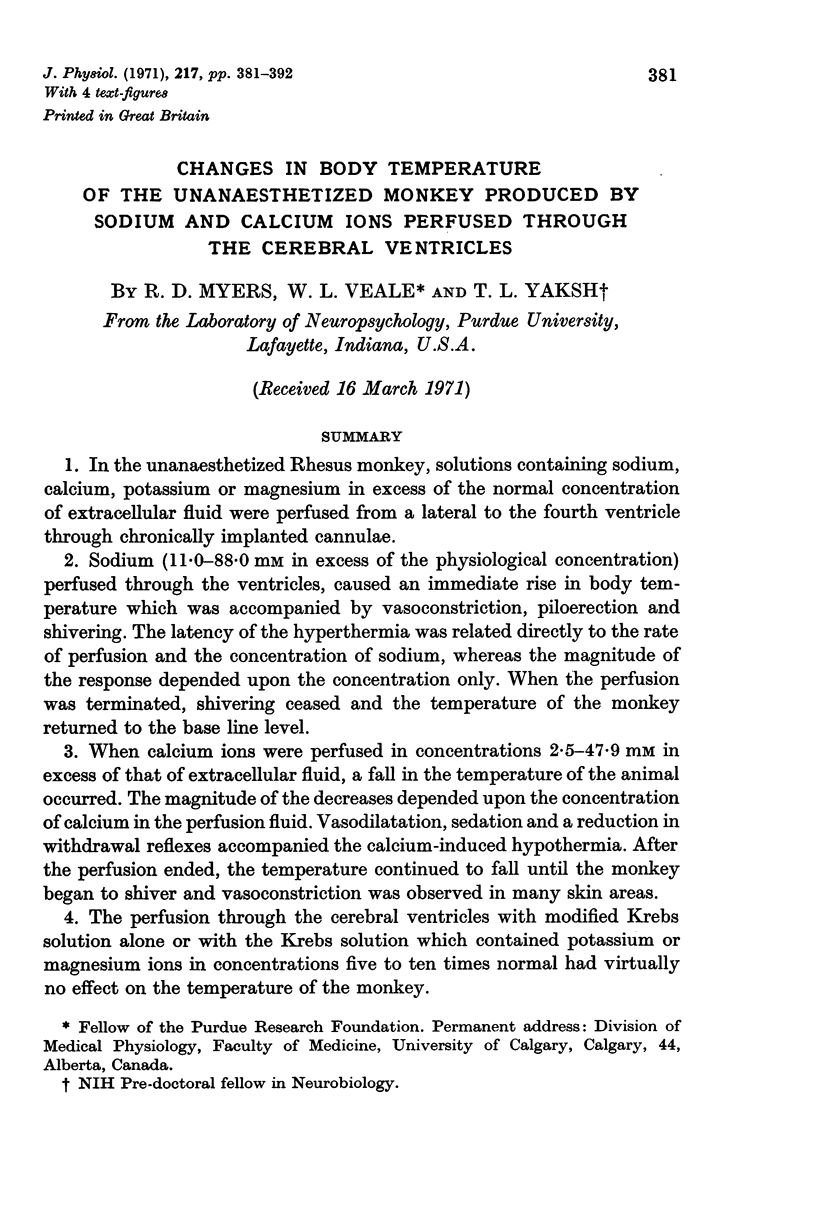
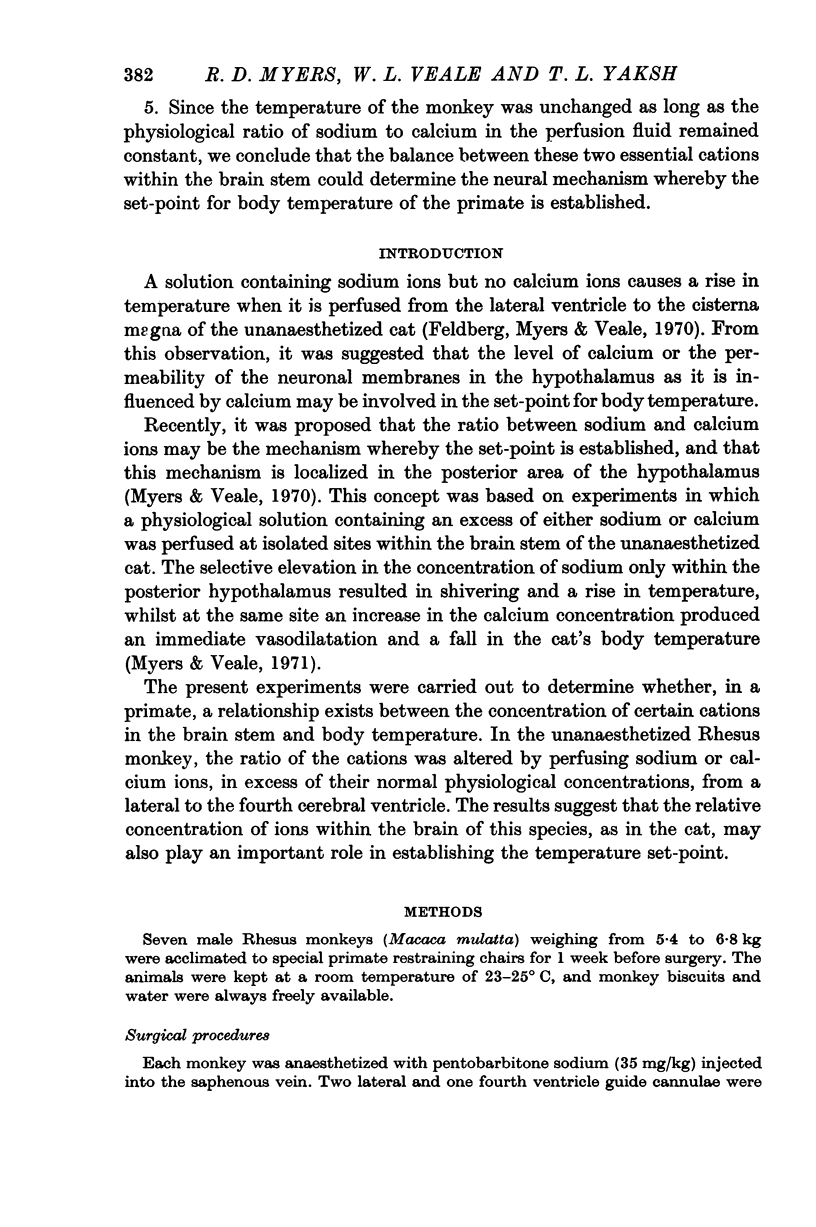
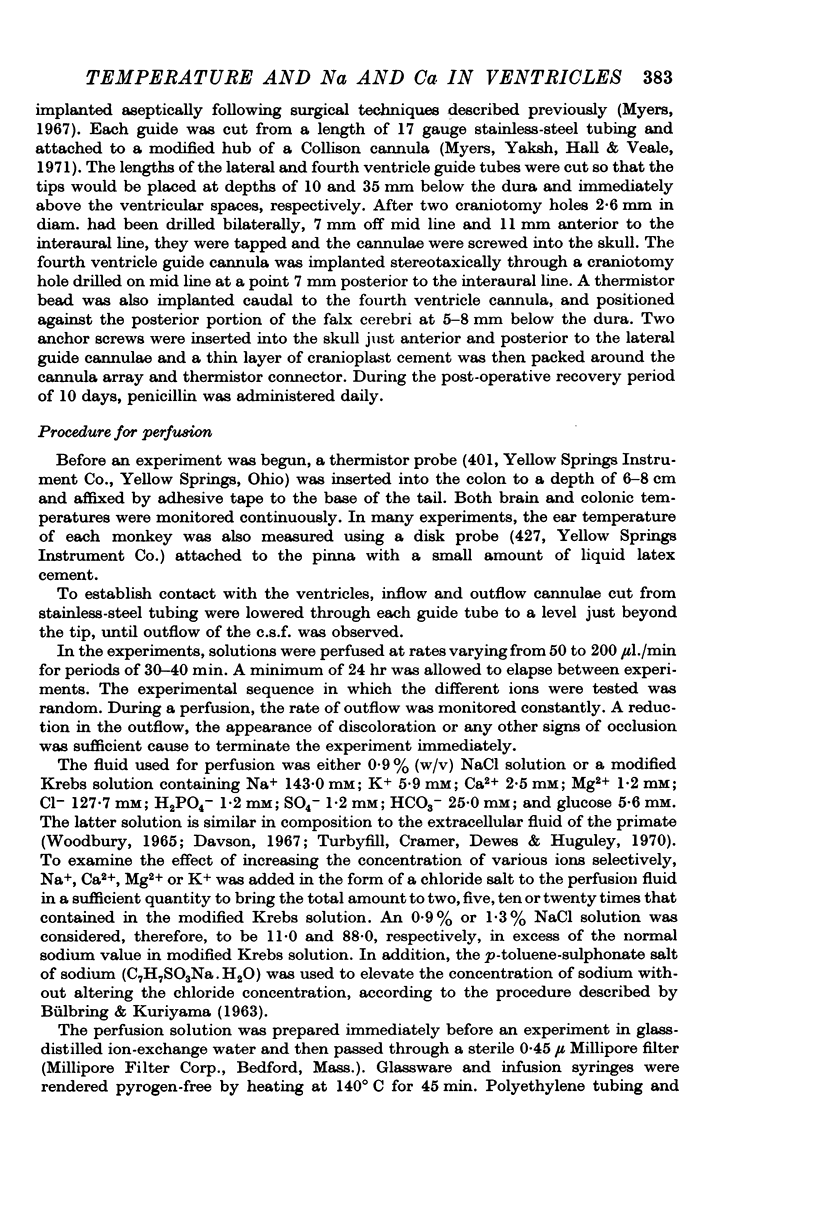
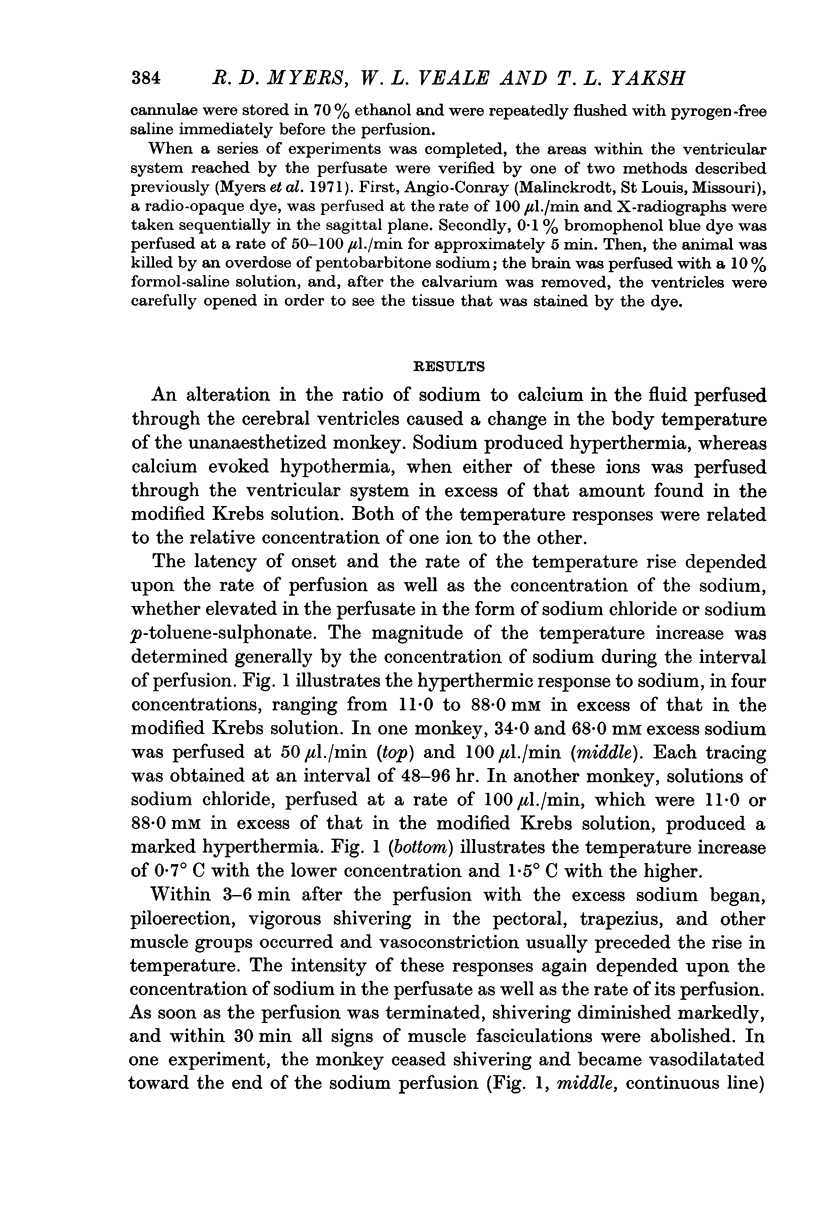

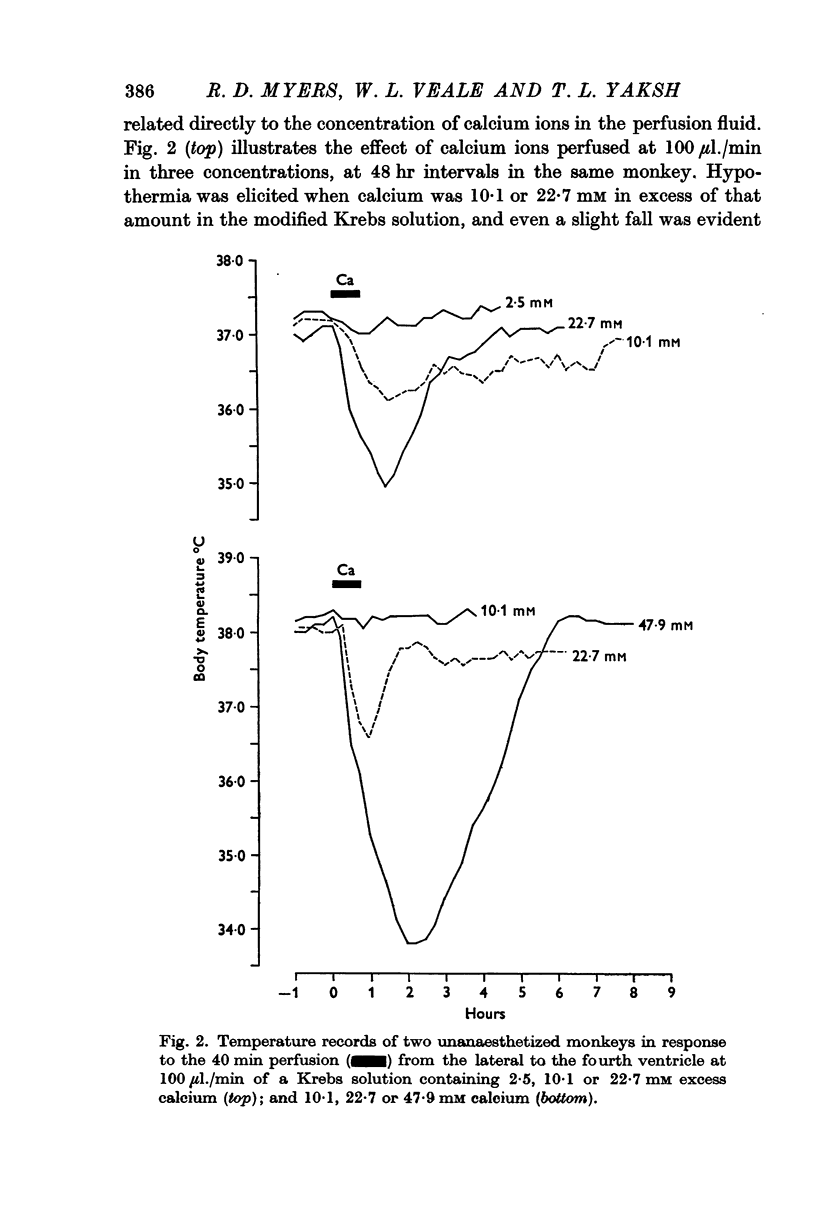
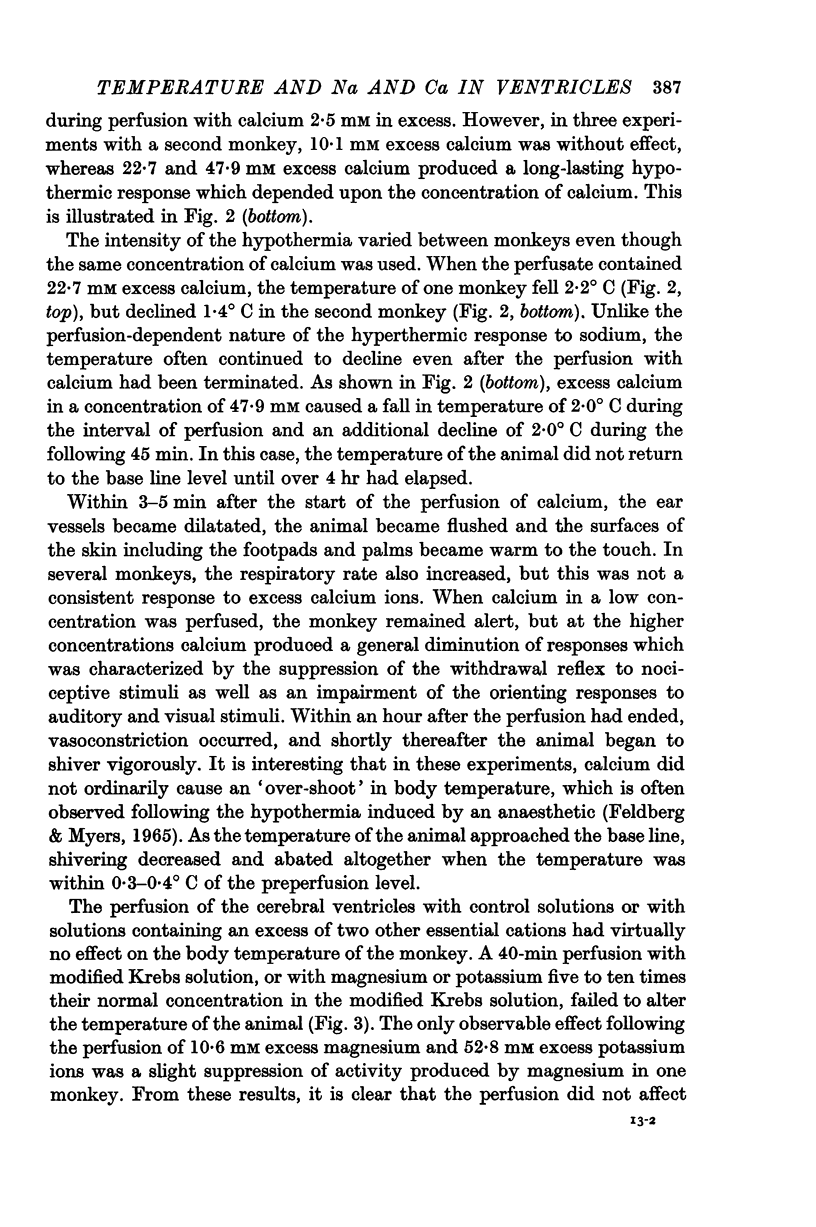
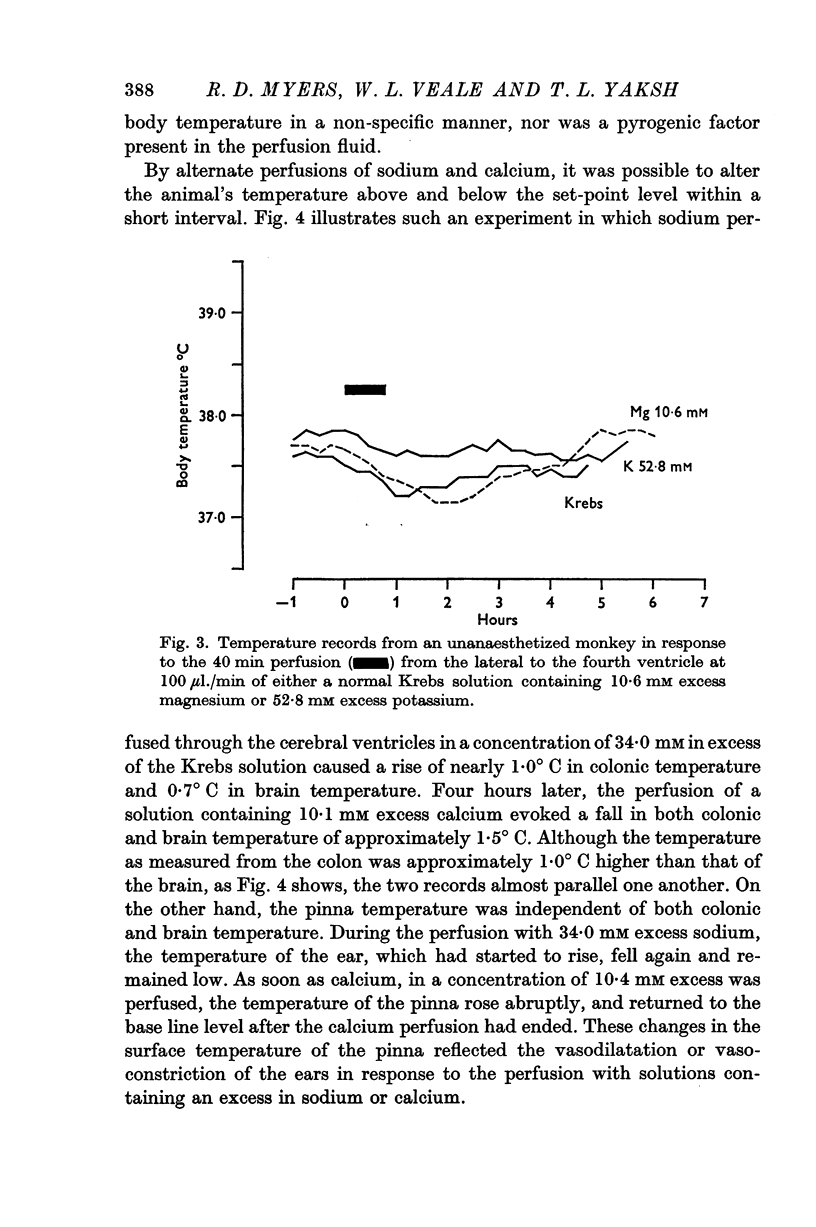
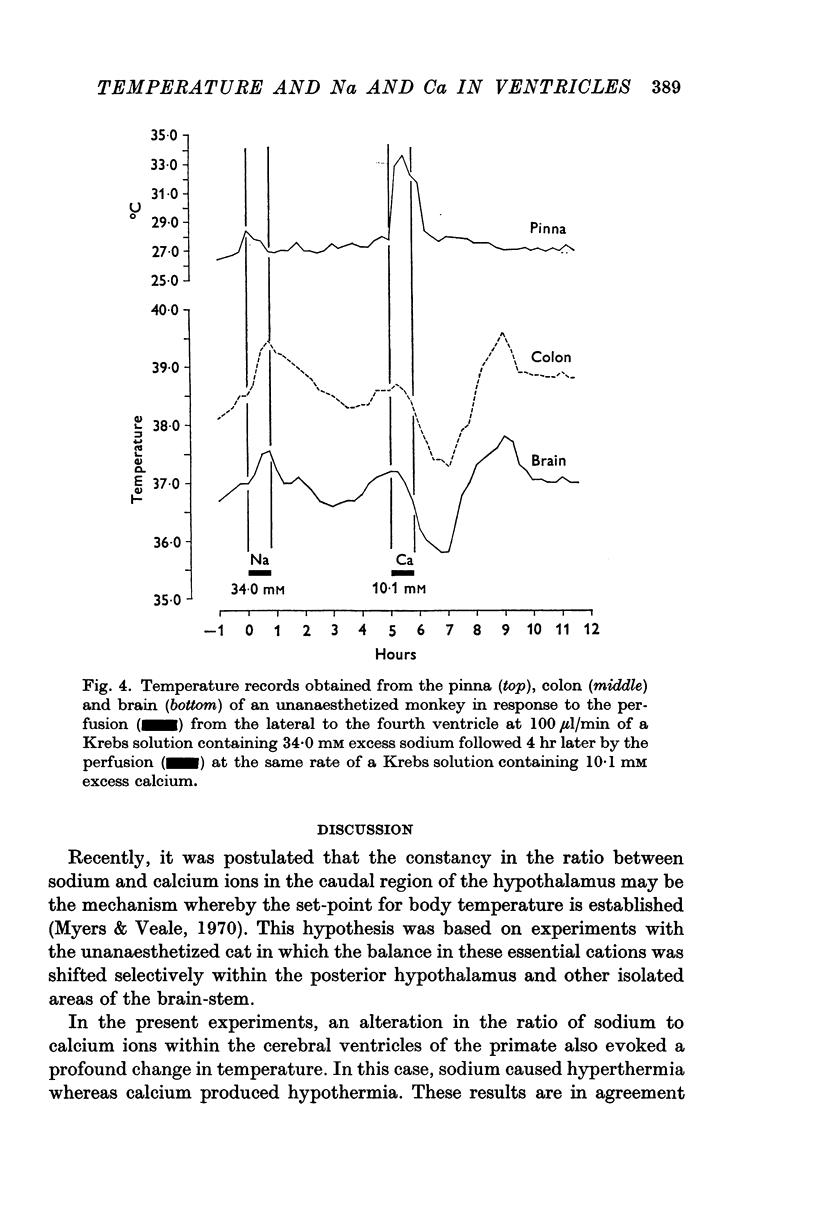
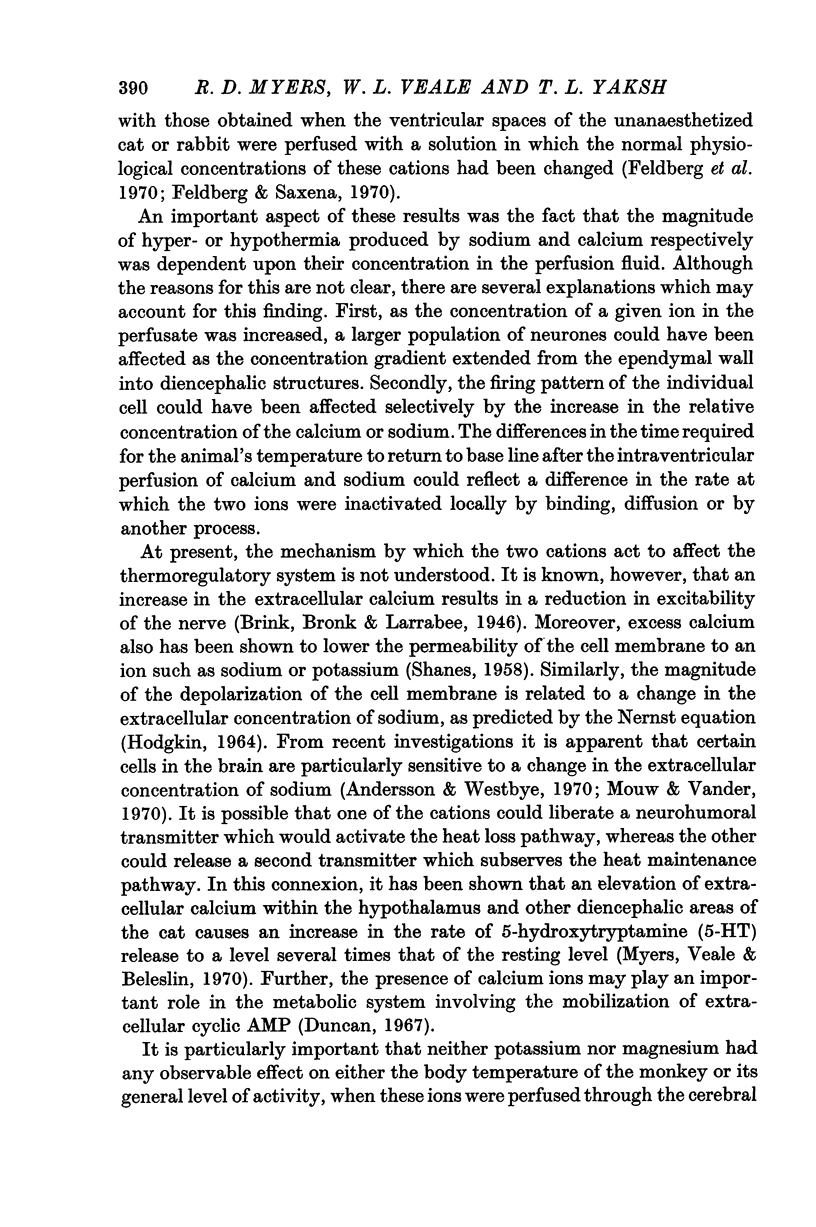
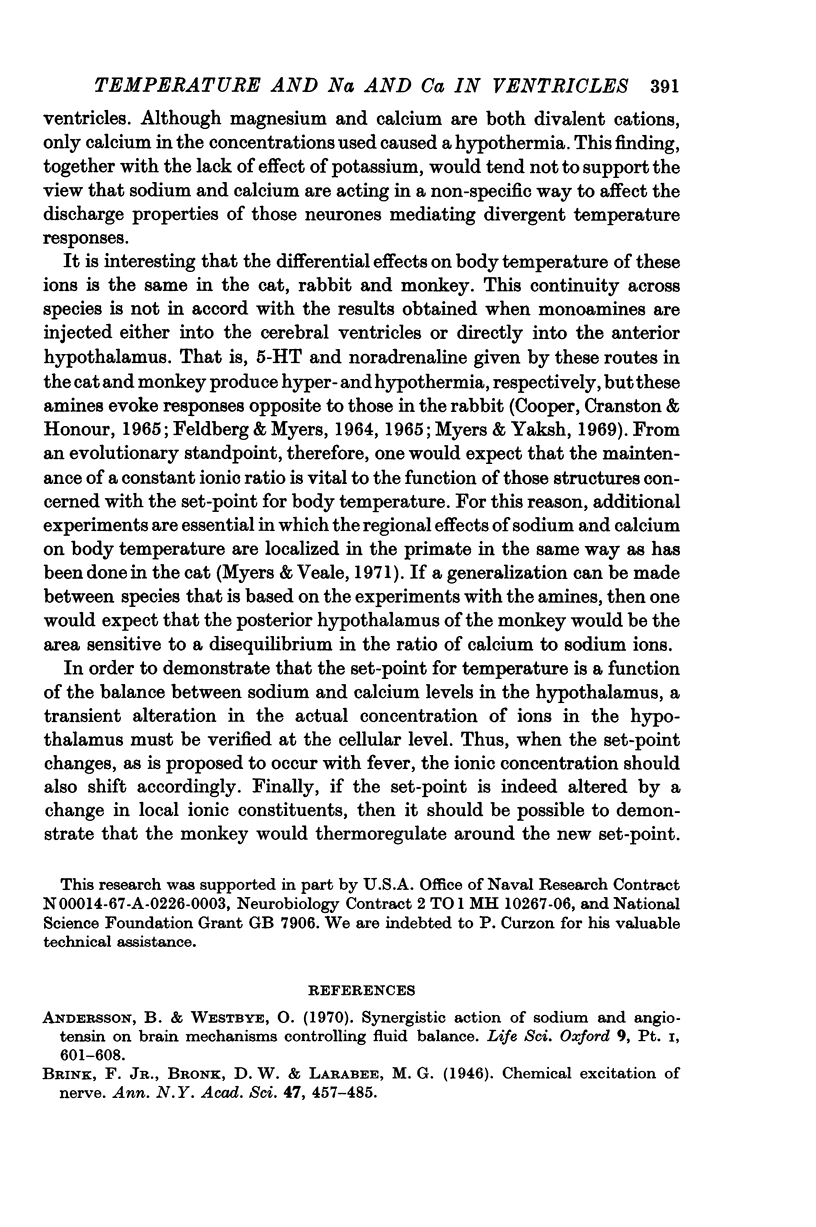
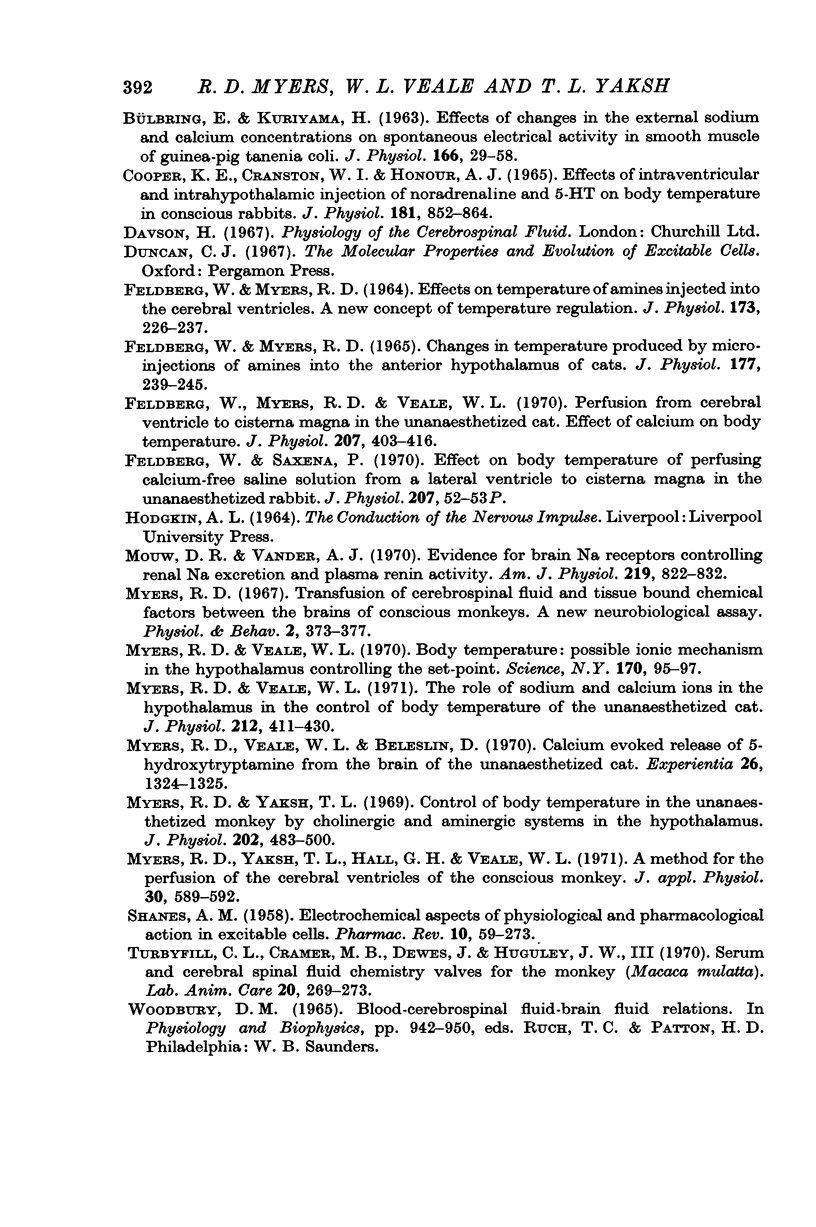
Selected References
These references are in PubMed. This may not be the complete list of references from this article.
- Andersson B., Westbye O. Synergistic action of sodium and angiotensin on brain mechanisms controlling fluid balance. Life Sci I. 1970 Jun 1;9(11):601–608. doi: 10.1016/0024-3205(70)90090-1. [DOI] [PubMed] [Google Scholar]
- BULBRING E., KURIYAMA H. Effects of changes in the external sodium and calcium concentrations on spontaneous electrical activity in smooth muscle of guinea-pig taenia coli. J Physiol. 1963 Apr;166:29–58. doi: 10.1113/jphysiol.1963.sp007089. [DOI] [PMC free article] [PubMed] [Google Scholar]
- Cooper K. E., Cranston W. I., Honour A. J. Effects of intraventricular and intrahypothalamic injection of noradrenaline and 5-HT on body temperature in conscious rabbits. J Physiol. 1965 Dec;181(4):852–864. doi: 10.1113/jphysiol.1965.sp007801. [DOI] [PMC free article] [PubMed] [Google Scholar]
- FELDBERG W., MYERS R. D. CHANGES IN TEMPERATURE PRODUCED BY MICRO-INJECTIONS OF AMINES INTO THE ANTERIOR HYPOTHALAMUS OF CATS. J Physiol. 1965 Mar;177:239–245. doi: 10.1113/jphysiol.1965.sp007589. [DOI] [PMC free article] [PubMed] [Google Scholar]
- FELDBERG W., MYERS R. D. EFFECTS ON TEMPERATURE OF AMINES INJECTED INTO THE CEREBRAL VENTRICLES. A NEW CONCEPT OF TEMPERATURE REGULATION. J Physiol. 1964 Sep;173:226–231. doi: 10.1113/jphysiol.1964.sp007454. [DOI] [PMC free article] [PubMed] [Google Scholar]
- Feldberg W., Myers R. D., Veale W. L. Perfusion from cerebral ventricle to cisterna magna in the unanaesthetized cat. Effect of calcium on body temperature. J Physiol. 1970 Apr;207(2):403–416. doi: 10.1113/jphysiol.1970.sp009069. [DOI] [PMC free article] [PubMed] [Google Scholar]
- Feldberg W., Saxena P. Effect on body temperature of perfusing calcium-free saline solution from a lateral ventricle to cisterna magna in the unanaesthetized rabbit. J Physiol. 1970 Apr;207(2):52P–53P. [PubMed] [Google Scholar]
- Mouw D. R., Vander A. J. Evidence for brain Na receptors controlling renal Na excretion and plasma renin activity. Am J Physiol. 1970 Sep;219(3):822–832. doi: 10.1152/ajplegacy.1970.219.3.822. [DOI] [PubMed] [Google Scholar]
- Myers R. D., Veale W. L., Beleslin D. B. Calcium evoked release of 5-hydroxytryptamine from the brain of the unanesthetized cat. Experientia. 1970 Dec 15;26(12):1324–1325. doi: 10.1007/BF02113006. [DOI] [PubMed] [Google Scholar]
- Myers R. D., Veale W. L. Body temperature: possible ionic mechanism in the hypothalamus controlling the set point. Science. 1970 Oct 2;170(3953):95–97. doi: 10.1126/science.170.3953.95. [DOI] [PubMed] [Google Scholar]
- Myers R. D., Veale W. L. The role of sodium and calcium ions in the hypothalamus in the control of body temperature of the unanaesthetized cat. J Physiol. 1971 Jan;212(2):411–430. doi: 10.1113/jphysiol.1971.sp009332. [DOI] [PMC free article] [PubMed] [Google Scholar]
- Myers R. D., Yaksh T. L. Control of body temperature in the unanaesthetized monkey by cholinergic and aminergic systems in the hypothalamus. J Physiol. 1969 Jun;202(2):483–500. doi: 10.1113/jphysiol.1969.sp008822. [DOI] [PMC free article] [PubMed] [Google Scholar]
- Myers R. D., Yaksh T. L., Hall G. H., Veale W. L. A method for perfusion of cerebral ventricles of the conscious monkey. J Appl Physiol. 1971 Apr;30(4):589–592. doi: 10.1152/jappl.1971.30.4.589. [DOI] [PubMed] [Google Scholar]
- SHANES A. M. Electrochemical aspects of physiological and pharmacological action in excitable cells. I. The resting cell and its alteration by extrinsic factors. Pharmacol Rev. 1958 Mar;10(1):59–164. [PubMed] [Google Scholar]
- Turbyfill C. L., Cramer M. B., Dewes W. A., Huguley J. W., 3rd Serum and cerebral spinal fluid chemistry values for the monkey (Macaca mulatta). Lab Anim Care. 1970 Apr;20(2):269–273. [PubMed] [Google Scholar]


